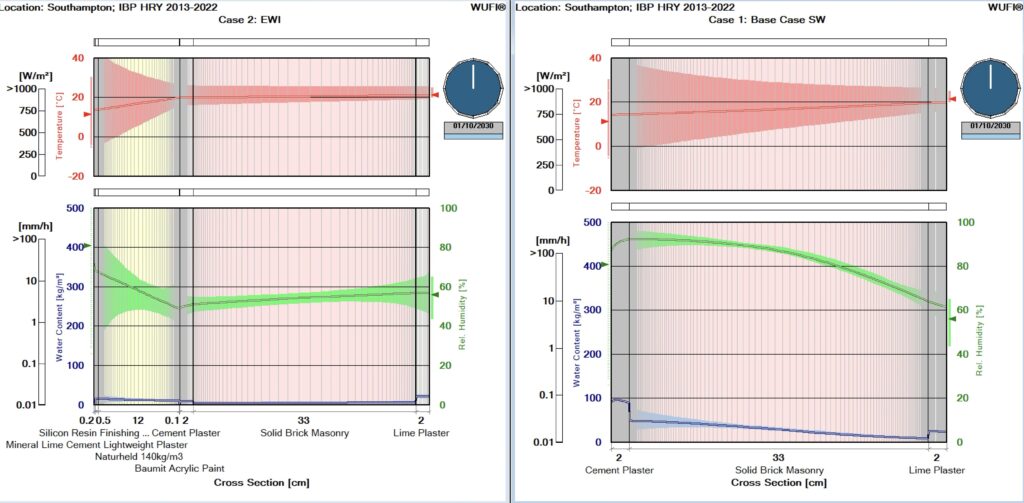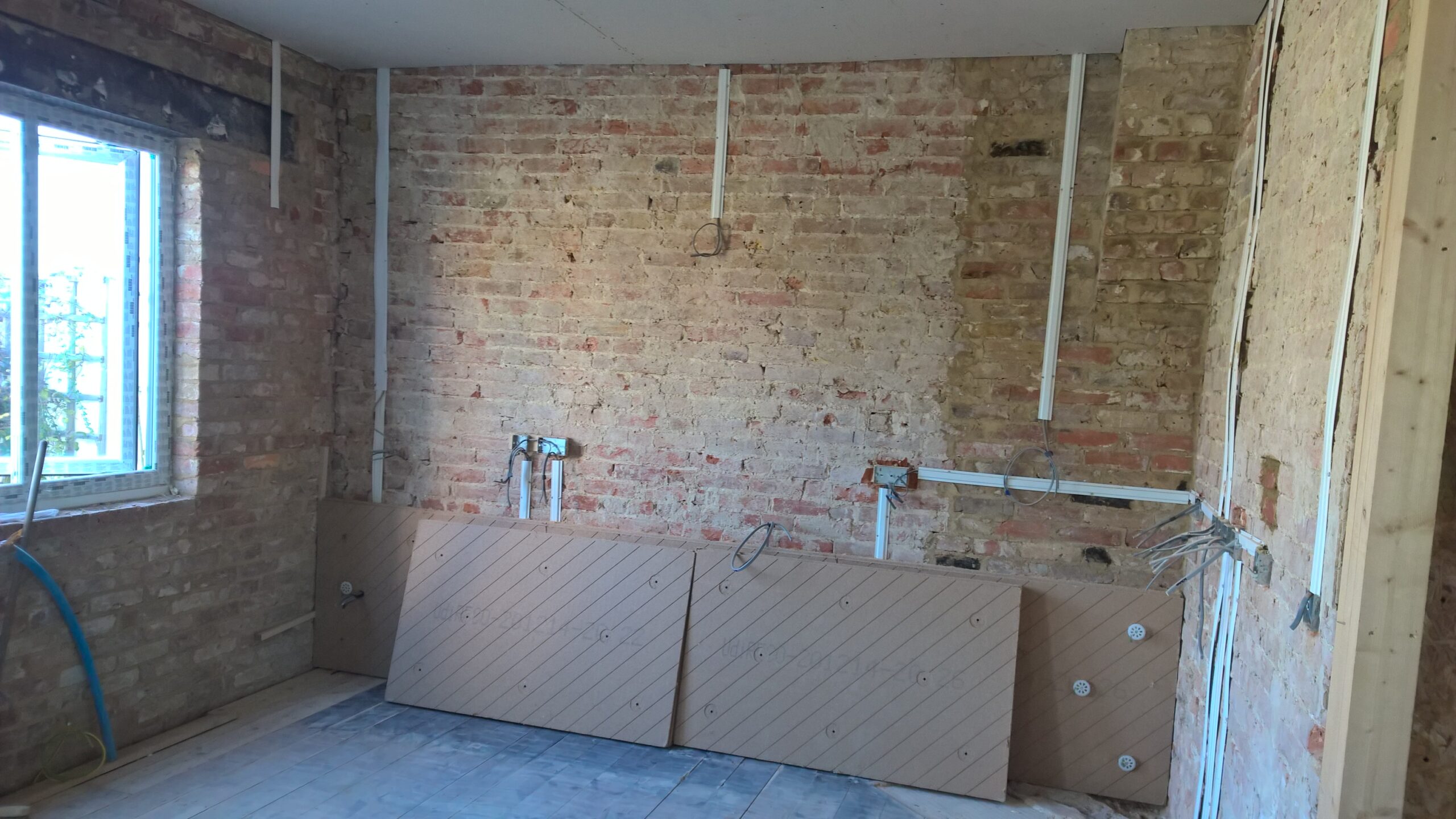When we are approached with an internal or external insulation project where the existing render is cement based or the existing plaster is cement based with a gypsum skim, it is nearly always assumed that it must be removed before applying a breathable insulation such as wood fibre insulation. This is often based on the assumption that cement and gypsum plasters/renders are not breathable and that this will cause a moisture issue with the insulation. However, if the existing plaster or render is intact and in good order, this is very often not the case.
Breathability
Cement based plasters are often assumed to be vapour impermeable (non-breathable) but in fact they are usually similar or only slightly less vapour permeable than lime plasters. Where the two products do vary is in their liquid moisture absorption/transfer rates, with lime products tending to transport water faster than cement based plasters or renders. But, lower water transport rates are usually beneficial in an external render where the aim is to prevent moisture ingress.
However, if the surface of the wall is defective and moisture ingress occurs, such as around window/door openings, because of the relatively slow movement of moisture purely by vapour diffusion, cement renders will tend to cause higher levels of moisture accumulation than lime based renders. Therefore, if cement based external renders are to be retained, it is important that they are checked to ensure that no rain is entering through gaps, cracks or any other entry points.
Masonry Damage
When existing cement based plasters/renders are in good condition and well bonded to the existing walls, they can be very difficult to remove without damaging the surface of the masonry underneath. The damage caused can range from removing a thin veneer of masonry from the surface to fracturing the bricks or stones in the outer surface of the wall to the point that extensive repair or replacement of thee masonry is required and so this process should not be taken lightly.
Embodied Carbon
From an embodied carbon perspective, it is far better to retain the existing plasters or renders as there is no additional carbon cost to doing so . The energy cost of stripping and disposing of existing surfaces and re-coating in a high embodied energy material like lime, is very significant. The energy (carbon) savings produced by the insulation may take many years to provide a net benefit when this re-plastering of walls is included and with the way the carbon already in the atmosphere is changing the climate, we need to do everything we can to minimise further unnecessary emissions.
External wall insulation
When adding breathable wood fibre insulation over existing cement based renders, you’re effectively eliminating the risk of any condensation within the existing structure, by allowing it to warm up and preventing weather form penetrating the surface. There is no risk that moisture moving from the interior will accumulate within the walls as it stays in the form of vapour at equilibrium between the wall and the interior environment.
Where conditions can still be an issue is at the base of the wall where ground moisture levels are high and where the internal and external floor levels are similar. Sometimes it may be necessary to change internal plasters to suit these conditions.
The additional benefit to retaining the plaster is that even if the masonry is irregular or soft underneath, the render itself is a good substrate to hold fixings and insulate over.
Internal wall insulation
As with utilising the existing cement render externally, using the internal plaster means you usually have a really firm, flat substrate into which you can fix your insulation boards. Additionally, there isn’t the mess, cost and disruption of removing and disposing of the plaster, making the installation quicker.
However, there are different considerations when retaining the existing plaster. The existing surface is going to become much cooler and the relative humidity will rise and so it is important that materials like wall paper or other linings are removed to ensure full contact with the masonry. This ensures the wood fibre boards do their job of buffering humidity at this junction and prevent liquid condensation forming. Surfaces should also be cleaned with a fungicidal wash to remove existing mould and fungi that invisibly grow on all of our internal surfaces.
Gypsum plasters need careful consideration at this point too. Gypsum is a completely natural plaster that exhibits good hygroscopic properties but when used in cool, damp areas can absorb too much moisture and become powdery. Applying insulation over the surface of the gypsum plaster cools it and raises the relative humidity at this point, so it is very important to check the likely conditions.
Hygrothermal modelling
So, how do we know whether it is possible to keep existing finishes? Hygrothermal modelling software is used to simulate hourly conditions, using actual or simulated weather data for the location and includes realistic issues such as rain driven moisture and air leakage from incomplete internal airtightness measures.
Using WUFI hygrothermal modelling software, we can confidently model scenarios to see how the temperature and moisture content of the whole wall changes as internal or external insulation is added. We can then interpret the results and see whether the existing material should be removed or not. This is often as much about the location of the project as how the walls are constructed as warmer, since drier climates are more lenient to keeping these existing surface layers.

The above images show how the temperature profile (in red) and the moisture profile (in green) vary across the wall. The right-hand model shows the moisture content of the wall with an external cement render and no insulation. The left-hand model shows how the moisture content of the wall drops significantly once the external wall insulation is added, with the cement render still in place.
So, before automatically removing all of your existing cement based finishes and replacing them with lime based products, check to see if you really need to. One of the main aims of insulation is to reduce carbon emissions but disposing of perfectly good surface finishes and replacing them with other materials that produce lots of carbon in their manufacture, reduces the beneficial impact of the work.
If you have any questions please contact us.

